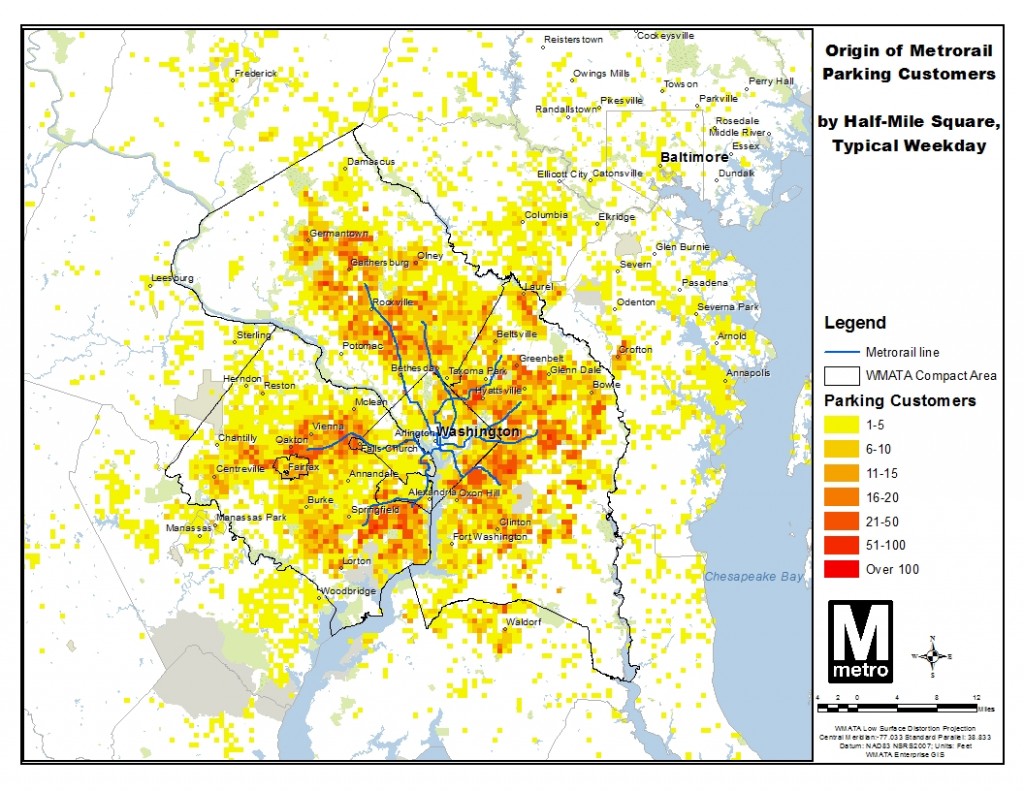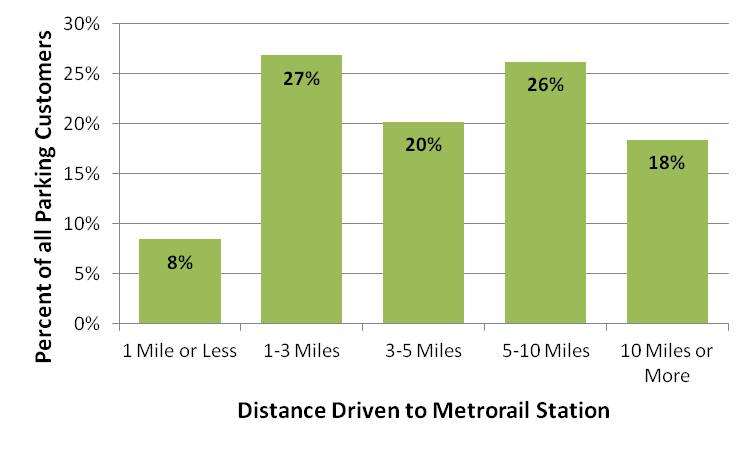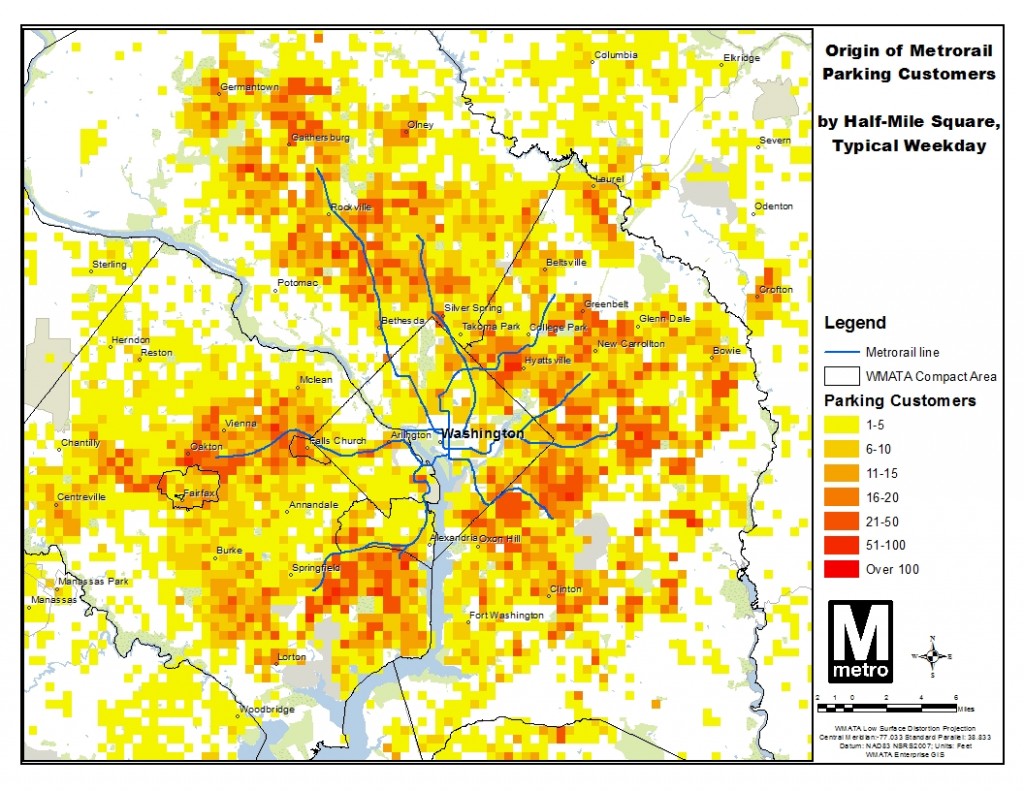Where Do Parking Customers Come From?
One-third of Metro parking customers drive from less than three miles to their station. But Metro’s importance can also be seen far across the greater Washington region, in this new visualization of parking customer’s origins.
Most Metrorail parking facilities primarily serve the neighborhoods immediately surrounding the station: 64%55% of parking customers come from less than five miles away, and 47%35% come from less than three miles away. However, some riders come from much farther away, particularly to end-of-line stations near major highways, such as Greenbelt, New Carrollton, and Vienna.
With approximately 60,000 parking spaces, Metro is one of the region’s largest parking operators. Our 2012 Metrorail Passenger Survey provides good insight into the travel patterns of rail customers, including those who drove and parked at any of Metro’s 35 stations offering daily parking. These parking customers represent around 15% of all rail trips on a typical weekday.
Where do parking customers come from? The map below shows the estimated origin of parking customers, by half-mile square. The yellow and orange colors show that some customers come from as far away as Baltimore, Dale City, and Frederick – but the darker red colors show that the majority of customers are clustered near the rail stations.

Metro’s role can be seen across the region. While two-thirds of parking customers drive from less than 5 miles away to a station, some drive considerably longer distances. (click for larger)
Here is the same map, focused more closely on Metro’s service area:
Both maps are also available in PDF: regional view, and the closer view.
Note that this analysis uses distance as-the-crow-flies, not via a street network, so actual distance driven is likely somewhat longer.
Update, 7/2/2013: due to an arithmetic error on our part, we had been over-stating short-distance parking customers as a share of the total. We fixed the error and replaced the green bar chart above with a corrected version.
What patterns do you see in this data? What jumps out at you? Does this information about the role of Metrorail parking surprise you? Let us know in the comments!




It strikes me that such short distances are easily bikeable and that commuters could be encouraged to bike to stations by promotions and better bike parking facilities. If this data is correct, this could cut a huge number of car trips annually.
I agree that this information could be used to focus efforts to promote cycling and walking, and reduce car trips. Is there data available that would make it possible to figure out how many parking customers there are at each Metro station, and break down driving distances?
It would be worthwhile to see how much of each station’s parking is utilized on a typical workday. If open spots are relatively impossible to find at a given station, it would be an argument for performance pricing. Market pricing for parking spots wouldn’t make sense if station parking lots tend to remain largely empty even on busy days. If it’s the latter’s case, it would be an argument to reduce parking spots in favor of transit-oriented development and the like. The above data shows that a significant portion of automobile trips can easily be accomplished through other means.
The end goal should indeed be to discourage driving, at least for the very short trips. More cars on the road translates into a less inviting pedestrian environment around Metro stations (where it would be needed most), as well as more pedestrian deaths, congestion, and pollution.
That said, the desire for replacing automobile trips with cycling or walking in these situations should not be overestimated. Biking or walking distances less than three miles is perfectly doable if you’re navigating a welcoming pedestrian and walking environments, and if that’s your full commute. The tolerance for such trips will be very low in areas that are generally only suited for automobile trips, and even lower when you have a long metro commute that follows in addition.
Many people already walk or bike. There are also many bus links to these stations.
You will have many people laughing if there is any money spent to further push for biking and walking if it significantly adds to the time or inconvenience. Bike gear does not meet all known dress codes, negotiating the 4-lane highways near outlying Metro stops may be treacherous, and hot weather biking (or walking) is not appealing to all.
Don’t forget the significant number of mature individuals or those with chronic (but treatable) medical conditions who work in the region. A significant hike or bike ride (in 90+ degree weather) may be inadvisable. People may also need their cars to make a quick connection from rail to pick up their children at day care.
These transportation modes – bus link, vehicle parking at the station, walking, or biking – are in place to give people options that are workable for each situation. There is no one-size-fits-all solution for everyone in the region, and those who are constantly pushing this “bike, walk” mantra just show their limited problem-solving capabilities and lack of consideration.
You’ll notice that the focus on this post was on short trips to the metro, not all car trips period. The more people you have driving to the metro, the more space you have to allocate for parking around the station and that adds up very quickly. The point is that when you have the option to build mixed development and the like, it seems like an incredible waste to spend premium space around such a robust subway system on car storage. We’ve all acknowledged above that it’s beneficial, perhaps even necessary, for far-away residents to make use of parking at a metro station. But when you’re talking about very short distance that CAN be easily traversed by either walking or biking by a significant portion of the population, it’s a waste.
Besides, if you feel that certain segments of the population would be immobile without a car (fair point) then it only makes sense to encourage those that CAN bike/walk to do so since it would mean less traffic and more parking spaces.
@EnoughAlready!
Of course there are people who will not be able to bike/walk or certain situations that don’t allow it. The broader point is that the bike situation around many stations is terrible – no bike infrastructure and nothing to make those “4-lane highways” safer for biking. That should be improved because there are many people who could be biking to the station but aren’t, and getting them on bikes can boost ridership with less investment than building more parking.